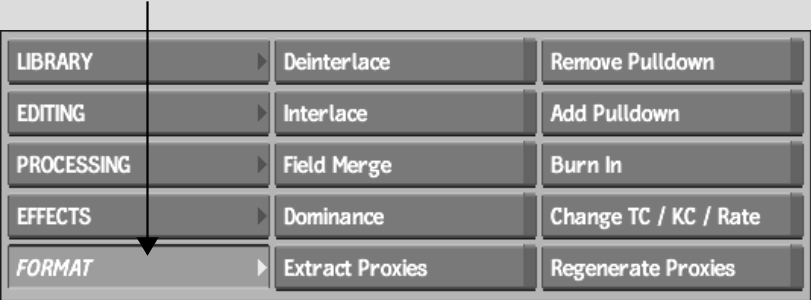Although 24p projects allow you to remove 2:3 or 3:2 pulldown from film-based sources on 60i tapes during the capture process, you can also capture the 60i sources as is, and then remove pulldown on the Desktop.
Desktop-based removal and insertion is also useful if your clips originate from the filesystem and were imported rather than captured from tape. Image import and export does not support automatic pulldown removal.
To remove pulldown on the desktop:



The pulldown options appear to the right of the menu panel.



(a) Timecode Mode box (b) Start TC Mode box
| Select: | To: |
|---|---|
| Keep TC Mode | Keep the 29.97 fps timecode of the clip from which you want to remove pulldown. |
| Change TC Mode | Change the 29.97 fps timecode to 23.97 fps timecode. |
| Select: | To: |
|---|---|
| Same Start Time | Use the 29.97 fps start timecode of the clip as the 23.97 fps start timecode of the result clip without converting it. |
| Same Start Frame | Convert the 29.97 fps start timecode of the clip to 23.97 fps and then use the result timecode as the start timecode for the result clip. |



The new clip with only the original 24 film frames is processed and appears on the destination reel.
To insert pulldown on the desktop:
Pulldown options appear to the right of the Format menu.



(a) Timecode Mode box (b) Start TC Mode box (c) Destination Timecode box
| Select: | To: |
|---|---|
| Keep TC Mode | Keep the 23.97 fps timecode of the clip from which you want to insert pulldown. |
| Change TC Mode | Change the 23.97 fps timecode to 29.97 fps timecode. |
| Select: | To: |
|---|---|
| Same Start Time | Use the 23.97 fps start timecode of the clip as the 29.97 fps start timecode of the result clip without converting it. |
| Same Start Frame | Convert the 23.97 fps start timecode of the clip to 29.97 fps and then use the result timecode as the start timecode for the result clip. |
| Select: | To output with: |
|---|---|
| Auto | 29.97 fps drop-frame or non-drop-frame timecode |
| 30 fps | 30 fps timecode |
| 29.97 fps DF | 29.97 fps drop-frame timecode |
| 29.97 fps NDF | 29.97 fps non-drop-frame timecode |
| Select: | To: |
|---|---|
| The first frame | Insert 2:3 pulldown. The result clip has the following sequence: AA, BB, BC, CD, DD. |
| The second frame | Insert 3:2 pulldown. The result clip has the following sequence: AA, AB, BC, CC, DD. |